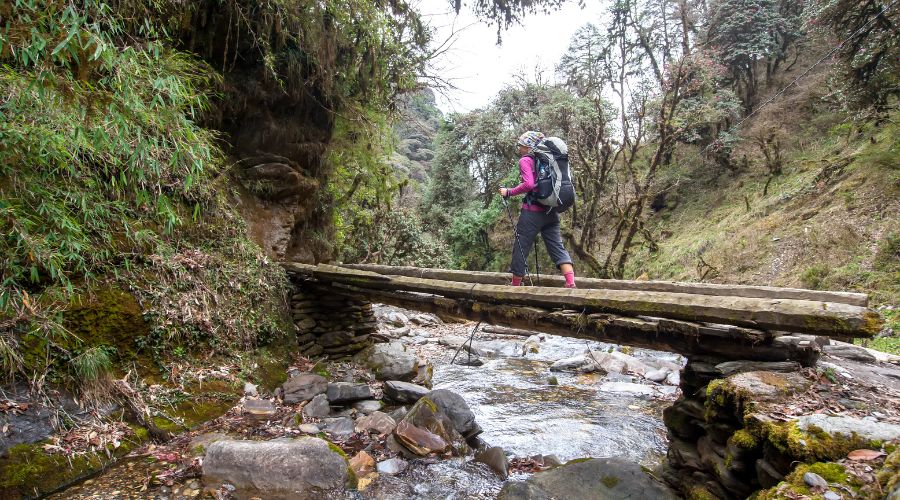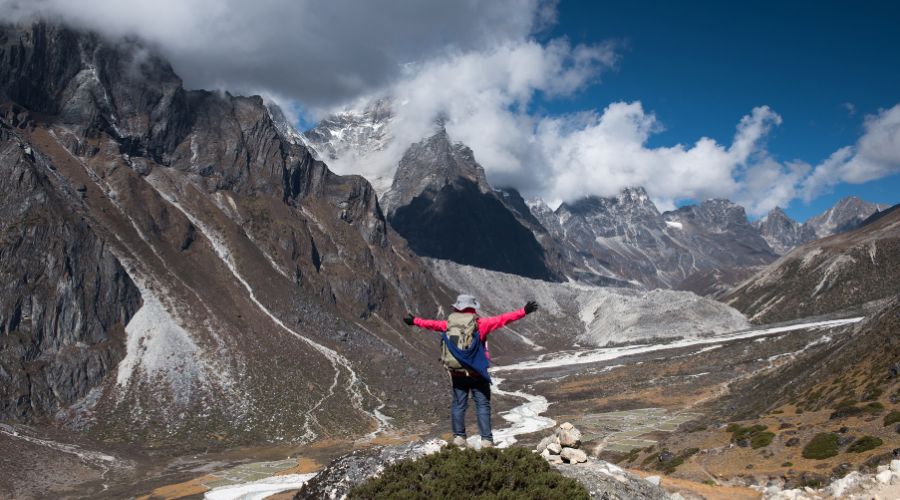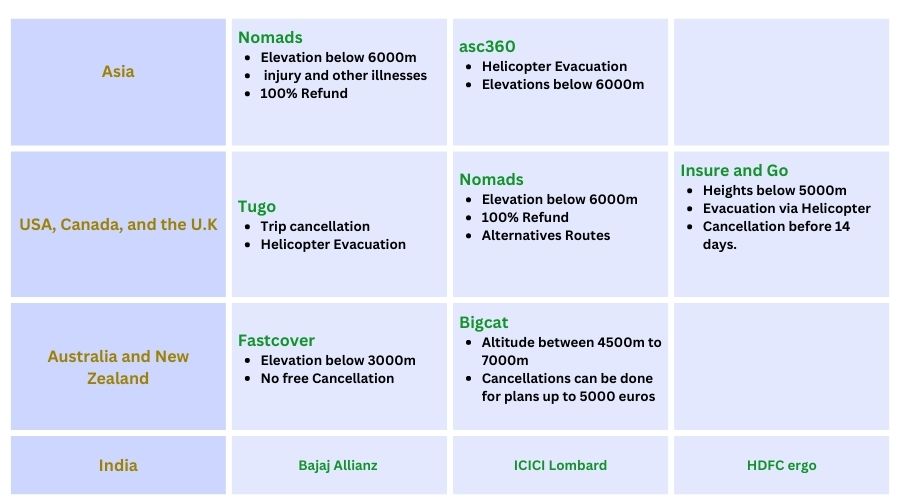
Best Travel Insurance For Trekking Up To 6000m In Nepal

Best Travel Insurance For Trekking Up To 6000m In Nepal
swotah travel
12438
23, 05 2023
The last thing you want to worry about when preparing for a trekking excursion to Nepal is the possibility of getting sick or injured. Having the appropriate travel insurance is crucial for this reason. The top travel insurance plans for trekking in Nepal up to 6000 meters will be covered in this blog post, along with tips on picking the ideal plan for you.
We'll also discuss some frequently asked questions and considerations to think about while purchasing travel insurance for a trekking trip in Nepal. So, if you're planning a trekking trip to Nepal, read on to learn more about getting the right insurance coverage.
Do you require any special travel insurance for trekking in Nepal?
Yes, having specialized travel insurance is necessary for trekking in Nepal. Trekking in Nepal is a difficult and occasionally risky endeavor. Having the appropriate travel insurance is crucial when trekking in Nepal in consideration of all these risks. With the right policy, you can protect yourself against any potential risks while enjoying your trek in Nepal.
Below are some of the reasons why you should consider trustworthy travel insurance before trekking in Nepal:
- Medical reasons: Trekking requires physical effort, which puts you at risk for accidents or unexpected medical needs. Insurance can cover those expenses and even continue your journey if it's not risky.
- Medical care during the evacuation: If you didn’t know earlier, helicopter evacuation doesn’t inherently include the cost of medical bills during the evacuation. Hence, you need to ensure that those costs are included in the insurance.
- Medical care in hospitals: You can be protected by insurance against the price of medical care and other expenses brought on by illness or injury after your evacuation.
- Unpredictable weather: Unexpected weather changes can result in mishaps and delays.
- Lost or stolen possessions: While walking in remote locations, your possessions could be misplaced or stolen.
- Emergency evacuation: You might require evacuation in a medical emergency, such as altitude sickness. Evacuation can be by ambulance or helicopter evacuation in remote areas.
- Blockage due to natural disaster: Unexpected events, such as a natural disaster, could cause your trip to be canceled.
- Trek cancellation or postponement: If your vacation is postponed or canceled, insurance can also help with making travel plans.

What does travel insurance not cover?
Despite travel insurance being a safe way to minimize the chances of unfortunate events and medical bills making a big hole in your pocket, there are certain things that are not covered. Below are the list of things that are marked as an exclusion in most of the travel insurance policies :
- Pre-existing medical conditions: People of different health conditions attempt to trek in Nepal. While it sounds brave(it is), most travel insurance does not cover costs for any pre-existing conditions like asthma and diabetes. Thus, consult the agent and ensure your fitness before finalizing your insurance.
- Pregnancy: If you get pregnant after reserving travel insurance, this will not be covered. However, you can either cancel the reservation or postpone(which is highly unlikely because you probably won’t be trekking for at least a few years). Ensure you have your medical reports to prove your pregnancy and smooth the cancellation process.
- Injuries because of Intoxication or drug abuse: It really hits differently when you have a couple of beers relaxing at the lap of the Himalayas. However, any accidents or injuries caused when being high on drugs or drunk are not covered in travel insurance. Ensure you are safe and sound and drink moderately while trekking because you will be in serious trouble if you need evacuation.
- Risky activities: You get an adrenaline rush when trekking Nepal because, understandably, the views of towering peaks are amazing. Nonetheless, if you intend to indulge in risky activities like swimming in rivers, climbing trees, diverging from easy routes, and mountain climbing, you might get hurt. Any unfortunate output from these kinds of events are not covered by any travel insurance. Hence, keep your head low and be aware of any possible risks from your actions.

What is the cost of travel insurance for trekking in Nepal?
Note: Costs are widely different everywhere on the internet
Depending on the length of your trip, the elevation you intend to reach and the coverage you choose, travel insurance for trekking in Nepal can cost anywhere between $30 and $150. As the trek's height and length increases, prices do as well. For a trek at 3000 meters, basic travel insurance will cost you about $30 to $50, and for a trek up to 6000 meters, more comprehensive plans can cost you between $100 to $150. Remember that this is only an estimate, and costs could change based on the insurance.
It's crucial to know precisely what coverage you're receiving for your money when choosing travel insurance for hiking in Nepal. Carefully examine the policy to ascertain whether the coverage satisfies your needs and expectations. Additionally, bear in mind that certain insurers provide special rates for multiple insurance purchases or for longer plans.
How high can I trek in Nepal with travel insurance?
The highest elevation travel insurance can cover in Nepal is 6000m. However, you must acknowledge that not all travel insurance covers this height. Most travel insurance runs out of effect after around 4000m elevation. Fortunately, most of the trekking destinations in Nepal don’t even hit the 6000m mark.
Below are some famous trekking destinations that are below 6000 meters:
-
Everest Base Camp Trek: 5,368 m / 17,598 feet
-
Everest Base Camp and Kala Patthar trek : 5,664 m / 18,519 feet
-
Langtang Valley Trek : 5,000 m / 16,347 feet
-
Annapurna Circuit Trek: 5,416 m / 17,769 feet
-
Manaslu Circuit Trek : 5,213 m / 17,103 feet
-
Mardi Himal Trek: 4,500 m / 14,764 feet
-
Ghorepani Poon Hill Trek : 3,210 m / 10,532 feet
-
Gokyo Ri Trek : 5,554 m / 18,222 feet
How often do people get sick trekking?
Trekking could be a physically exhausting endeavor, and being away from the comforts of home elevates your risk of becoming ill. It is crucial to be aware of the risks and take the necessary precautions, and it is impossible to determine how frequently people get sick while trekking in Nepal.
As long as they take the necessary precautions, people generally do not get terribly sick while trekking in Nepal. This entails watching your diet, drinking enough water, and not pushing yourself too hard.
Nevertheless, some conditions have the potential to cause illness. One of the most common illnesses that might impact trekkers in Nepal is altitude sickness. Symptoms can include tiredness, migraines, nausea and vomiting. It is critical to be conscious of these symptoms; if required, you must rest or descend.
Overall, it can be very challenging to determine the precise number of trekkers who fall ill while trekking in Nepal. Therefore, taking the best precautions to stay healthy throughout your entire journey will considerably lower your risk of becoming sick.
Best travel Insurance companies for trekking in Nepal
Plenty of travel insurance options are available for people who intend to trek in Nepal. It’s hard to list one travel insurance package because they all have their own policies and pricing. However, based on geographical location, a list of travel insurance that might benefit you is below.

Travel insurance for citizens of Asia
-
Explorer Plans and Standard Plans: By nomads
-
Applies for elevation below 6000m
-
Bills covered in medical centers for injury and other illnesses.
-
Plans can include policies to refund in case trek cannot be completed for valid reasons.
-
Trekkers might have options to take alternative routes if the route is safe.
-
Everest Base Camp Trek Insurance: asc360
-
Evacuation via helicopter for medical reasons like altitude sickness
-
Applies for elevations below 6000m
-
Cancellation is available with charges around 1000$
Travel insurance for citizens of the U.S, Canada, and the U.K
Features
-
Applies for height below 6000m
-
Evacuation via helicopter
-
Trip cancellation well ahead of time will not result in a penalty.
-
Explorer Plans and Standard Plans: By nomads
Features
-
Applies for elevation below 6000m
-
Bills covered in medical centers for injury and other illnesses.
-
Plans can include policies to refund in case trek cannot be completed for valid reasons.
-
Trekkers might have options to take alternative routes given that the route is safe.
-
Applies for heights below 5000m
-
Evacuation via Helicopter
-
Cancellation not allowed after 14 days of receiving policy information
Travel insurance for citizens of Australia and New Zealand
-
Insurance By: Fastcover
-
Applies for elevation below 3000m
-
Cancellation fees can cost around 1200$
-
Hospitalization and medical bills are covered during the trek
-
Insurance By: Bigcat
-
This applies for altitudes between 4500m to 7000m
-
Option to choose between three plans
-
Cancellations can be done for plans up to 5000 euros
Travel Insurance for citizens of India
Honourable Mentions
-
British Mountaineering Council (BMC) (citizens from UK)
-
DogTag (citizens from UK)
-
JS Insurance (citizens from UK)
-
Snow cards (citizens from UK)
-
HCCmis (citizens from US- canada)
-
IMglobal (citizens from US- canada)
-
Travel guard (citizens from US- canada)
-
Travel lite (citizens from US- canada)
-
Global rescue (Worldwide)
-
Europe Assistance (Rest of Europe)
-
Racc Spain and Fedmi Spain (citizens of Spain)
-
Hens Merkur (citizens of germany)
-
CoverMore (citizens of Australia and New Zealand)
-
Bharati AXA travel Insurance (citizens from India)
-
Reliance travel Insurance (citizens from India)
Conclusion
To conclude, many insurance options in Nepal wish to trek from all around the globe. However, all these plans have their own set of features and pricing. Additionally, some travel plans only cover up to a certain height like 3000m or 4000m. You need to do your research thoroughly before finalizing a plan because there are fewer insurance plans that cover up to 6000m or even above.
Make sure that you read the policy thoroughly and ask questions in case of any confusion. Moreover, reserve a plan only after you are absolutely sure of attempting a trek in Nepal. This will be beneficial because most insurance plans deduct fees in case a plan's cancellation or postponement occurs.
NEWSLETTER SIGNUP
Sign up to receive our trip ideas and travel offers!
Get updates and Exclusive Offers up to 20% Discount








